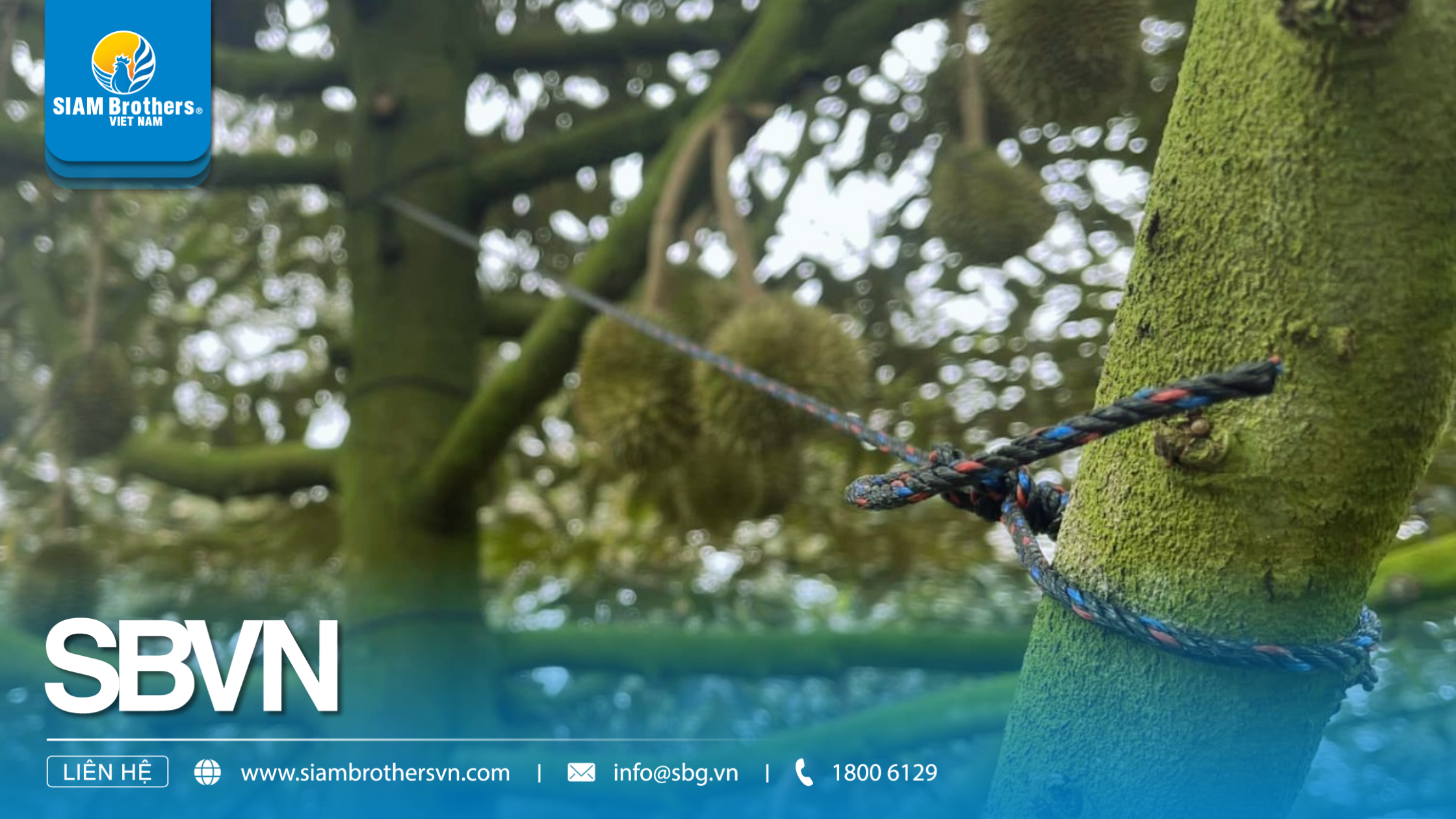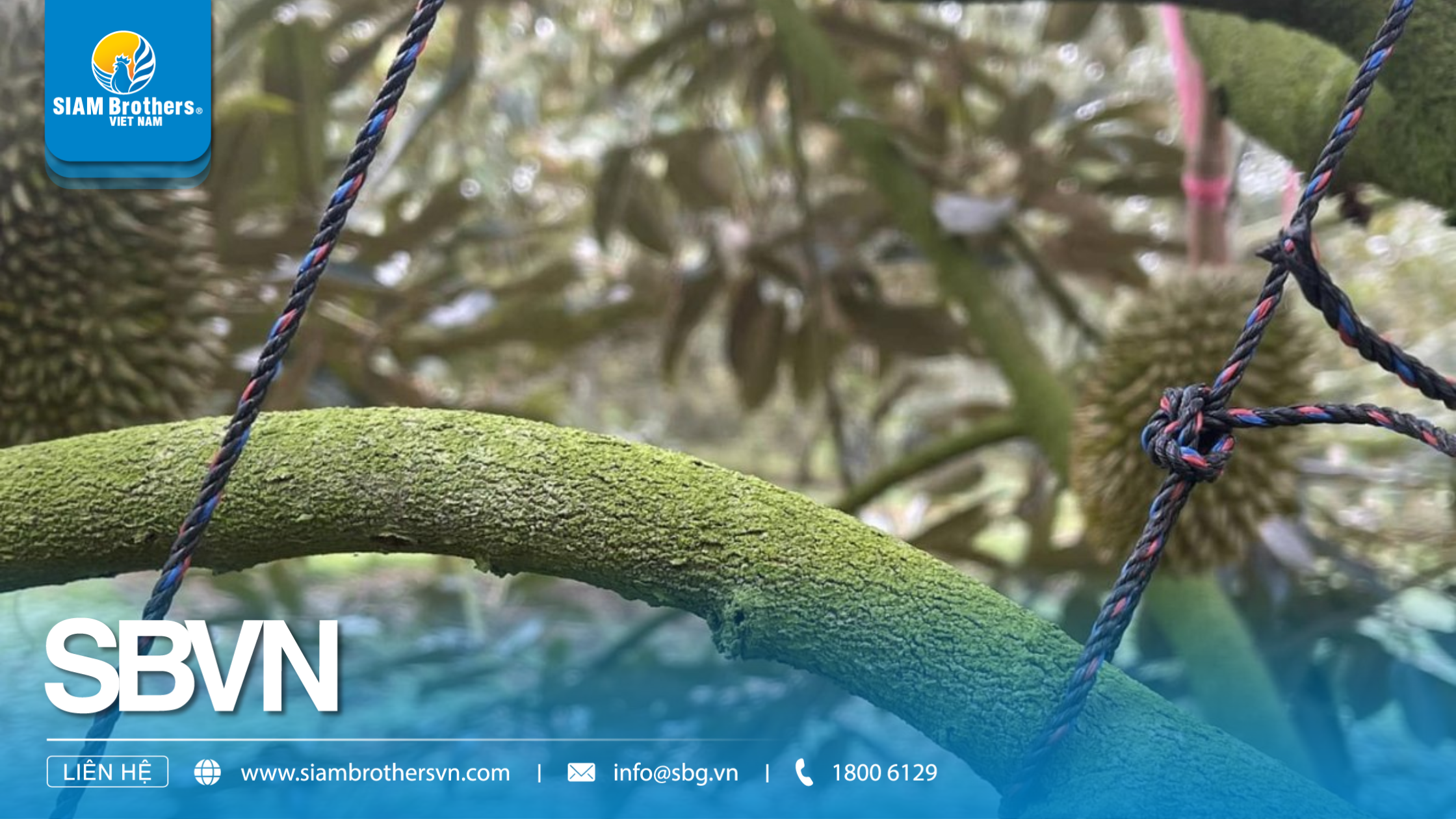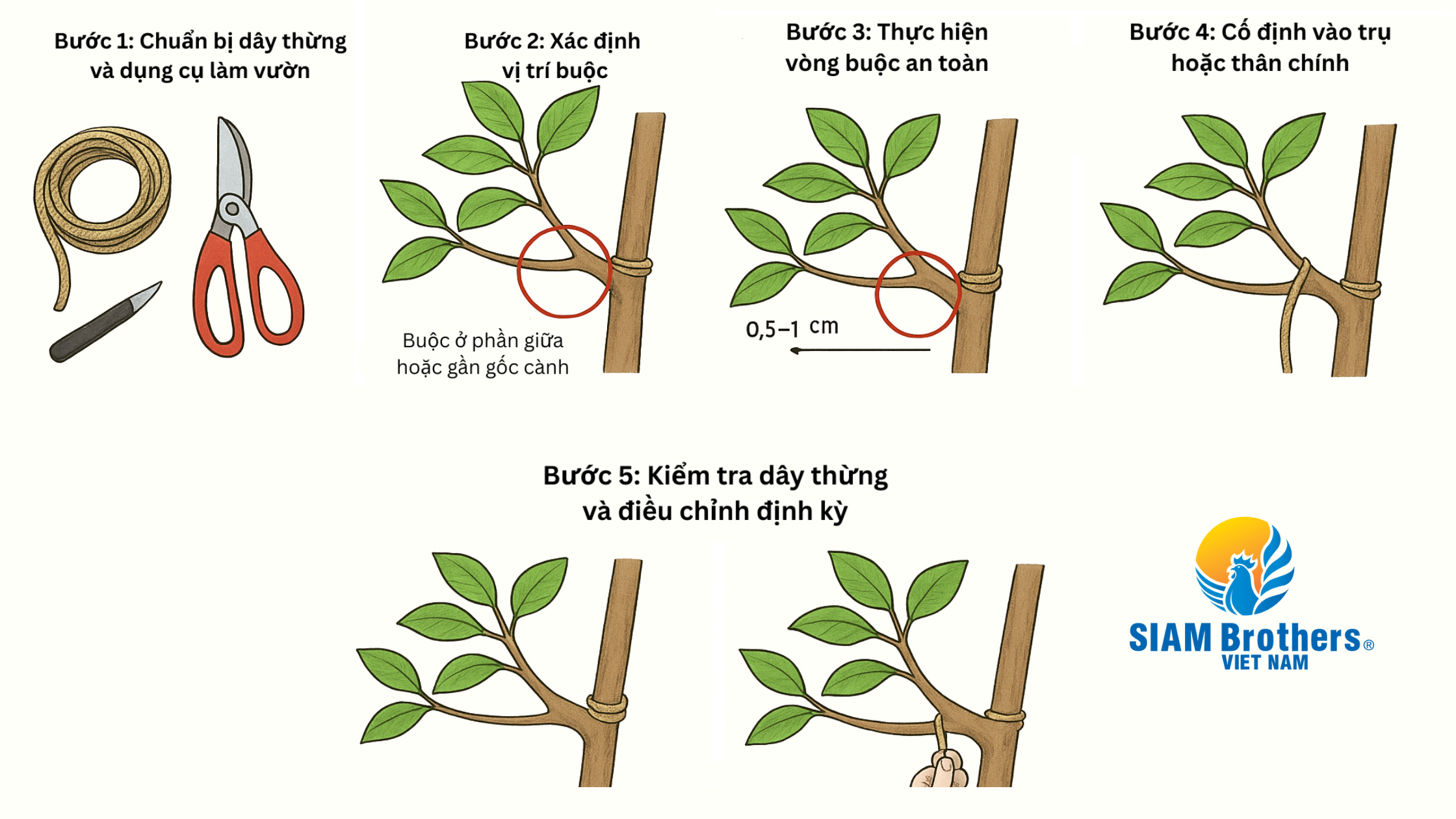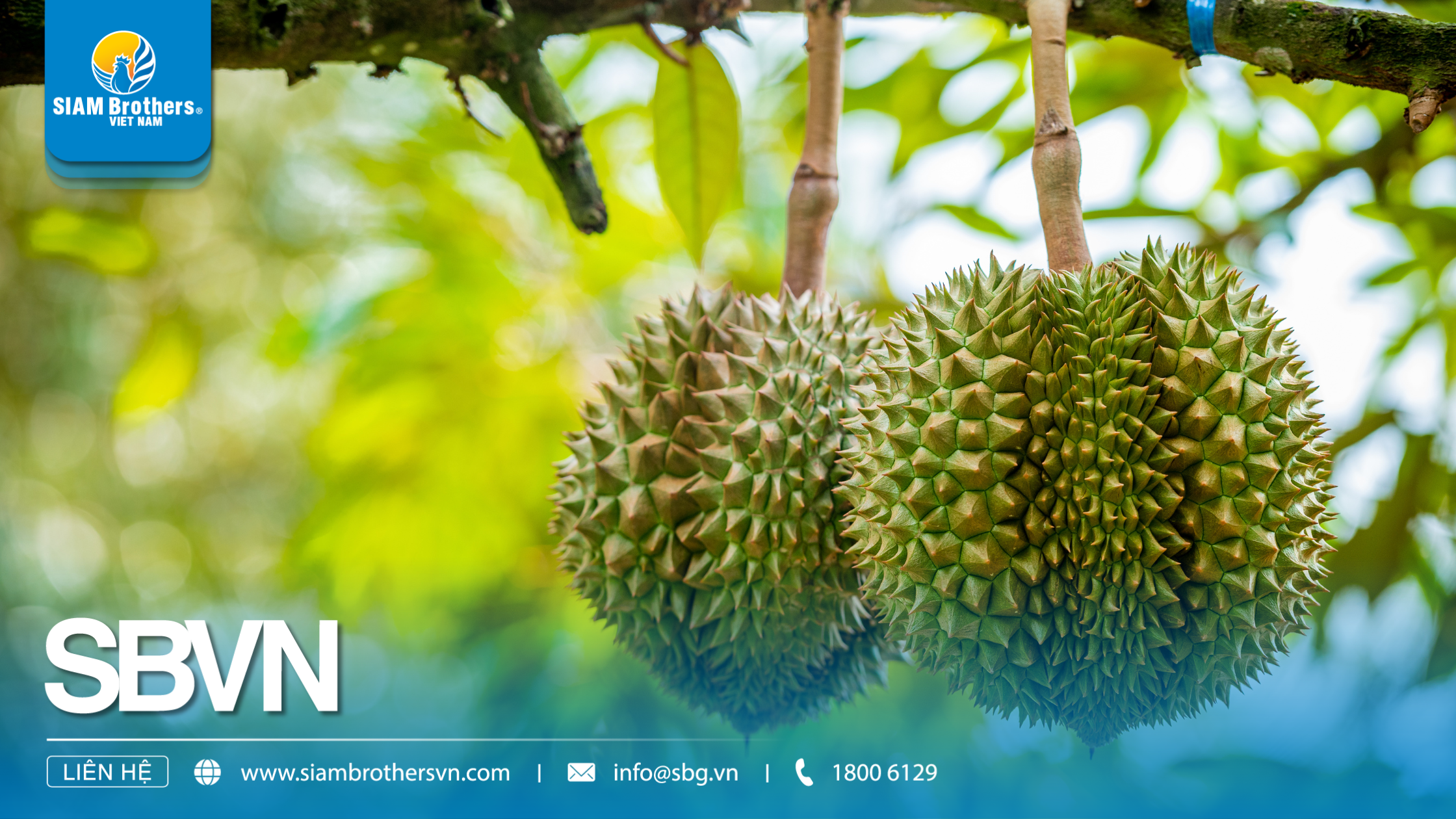Durian branch tying rope is not just a supporting tool but also a “secret” that helps farmers protect their trees during the flowering and fruit-bearing seasons. Choosing the right type of rope and tying it with the correct technique will strengthen the branches, reduce breakage during strong winds, or when the fruits become too heavy. In this article, SIAM Brothers Vietnam (SBVN) shares practical experiences from farmers, detailed tying techniques, and important notes to ensure safe tree growth, higher yields, and peace of mind when investing in your durian orchard.
1. The Importance of Proper Durian Branch Tying
1.1 Strengthening Tree Structure
- Durian branch tying rope helps secure branches in place, minimizing the risk of breakage during storms or heavy rain.
- Reduces the risk of young or ripened fruits overloading the branches.
1.2 Supporting Natural Growth
- Specialized ropes provide branch support without damaging the tree bark.
- Prevents overly tight knots that could block nutrient circulation.

1.3 Optimizing Yield and Fruit Quality
- Healthy branches improve the tree’s ability to nourish fruits.
- Encourages more consistent flowering and fruit setting, ensuring stable productivity.
1.4 A Sustainable Solution for Farmers
- High-quality ropes reduce the need for frequent replacement.
- Ensures long-term, sustainable, and safe tree care.
2. Criteria for Choosing Quality Durian Branch Tying Rope
2.1 Durability and Load-Bearing Capacity
- Ropes must withstand heavy loads during fruiting or strong winds.
- Avoid ropes that rot or stretch too quickly, losing their effectiveness.
2.2 Tree-Safe Materials
- Prioritize ropes made from PP, PE, or synthetic fibers, offering flexibility and elasticity.
- Gentle on the bark, ensuring uninterrupted nutrient flow.
2.3 Weather Resistance
- Ropes should resist UV rays and withstand harsh outdoor conditions.
- Reduces the frequency of replacement, saving costs for farmers.
2.4 Flexibility and Ease of Use
- Available in multiple sizes, easy to tie and untie, suitable for both young and mature branches.
- Makes orchard care and branch adjustment more convenient.
2.5 Reliable Source and Trusted Brand
- Choose products from experienced manufacturers with transparent quality assurance.
- SIAM Brothers Vietnam provides premium agricultural ropes trusted by professional farmers.

3. Practical Durian Branch Tying Experiences from Farmers
3.1 Choosing the Right Time to Tie Branches
- Best done during fruit development stages for timely support.
- Avoid tying during heavy rain or when branches are wet, which can cause slipping.
3.2 Safe Knotting Techniques
- Use a loose circular knot that secures the branch without tightening excessively.
- Apply simple, easy-to-untie knots for quick adjustments when needed.
3.3 Proper Knot Placement
- Secure ropes around the middle or near the branch base, not at the tips.
- Avoid weak spots or fragile bark areas to prevent damage.
3.4 Regular Inspection and Rope Replacement
- Check ropes frequently, especially during storm seasons or rapid fruit growth.
- Replace ropes if they show signs of rotting, stretching, or leaving marks on the bark.
3.5 Using High-Quality Ropes
- Farmers recommend ropes made from synthetic fibers like PP or PE for their durability and weather resistance.
- Products from reputable brands such as SIAM Brothers Vietnam are considered safe and sustainable.

4. Proper Techniques for Tying Durian Branches with Rope to Prevent Breakage
Tying durian branches is not just about fastening them with rope. If done incorrectly, branches can easily be injured or broken when carrying heavy fruits. Below is a step-by-step guide on how to use dây thừng cột cành sầu riêng properly, based on practices applied by many experienced farmers:
- Choose durian branch tying rope made from PP, PE, or durable synthetic fibers.
- Use sharp scissors or a knife to cut the rope to the appropriate length for each branch.
Step 2: Identify the tying position
- Tie around the middle or near the base of the branch, avoiding weak spots or areas with wounds.
- Select a position lower than the fruit-bearing point to reduce load pressure.
Step 3: Make a safe loop
- Wrap the rope loosely around the branch, never tightening it too much.
- Leave a 0.5–1 cm gap so the branch has room to grow without the rope cutting into the bark.
Step 4: Secure to a support or main trunk
- Fasten the rope end to a sturdy support pole, the main trunk, or a frame.
- Adjust the tension to keep the branch balanced without causing stress.
Step 5: Inspect and adjust regularly
- Check the rope frequently, especially during stormy weather or rapid fruit growth.
- Replace ropes showing signs of loosening, fraying, or damaging the bark.

5. Common Mistakes When Using Durian Branch Tying Rope
5.1. Tying too tightly
Over-tightening restricts sap flow, weakening the branch and increasing breakage risk.
5.2. Choosing the wrong type of rope
Using weak or rough ropes may scratch the bark, allowing pests and fungi to enter.
5.3. Tying too loosely
If the rope is not secure enough, branches may slip, sway, and eventually break under heavy fruit loads.
5.4. Skipping regular inspections
Durian branches grow quickly, and ropes may become too tight over time. Failure to adjust can cause deep cuts into the bark.
5.5. Tying at the wrong position
Tying ropes too close to young tips weakens branches, making them unable to support fruits.
6. Frequently Asked Questions About Durian Branch Tying Rope
6.1. What type of rope is best for tying durian branches?
Choose soft yet durable ropes with high tensile strength. PP or PE ropes are widely trusted by farmers.
6.2. Where is the best position to tie the rope?
Tie around the middle of the branch—avoid the tip and the very base. This ensures strong support without harming growth.
6.3. How often should ropes be checked and replaced?
Check every 1–2 months. Replace or loosen ropes if they become too tight or show signs of wear.
6.4. Can ropes be reused?
Yes, if they remain strong and intact. However, for young trees, new ropes are recommended for safety.
6.5. Do durian branch tying ropes affect yield?
When tied correctly, ropes protect branches, reduce breakage, and improve balanced growth. Poor-quality ropes or improper tying can damage branches and lower yield.
6.6. Can nylon string replace tying rope?
Nylon can be used temporarily but tends to cut into branches as they grow. Durian branch tying rope is softer, more durable, and safer.
6.7. When should ropes be removed?
Once the branch has grown strong enough, usually within 6–12 months, remove the rope to prevent restriction.
6.8. Are there specialized ropes for durian branch tying?
Yes. Agricultural ropes designed for tree support are soft, lightweight, and strong. SIAM Brothers Vietnam provides ropes that are safe, durable, and trusted by farmers.
6.9. Where can I buy high-quality durian branch tying ropes?
Always choose reliable manufacturers and distributors. SIAM Brothers Vietnam is a long-standing brand offering durable, safe, and high-standard ropes trusted by professional farmers.

Durian branch tying rope is not just a support tool—it is a sustainable solution that keeps branches stable, reduces breakage, and ensures balanced growth for higher yields. Choosing quality rope, applying proper tying techniques, and avoiding common mistakes will maximize efficiency and reduce long-term costs.
If you are looking for durable and safe durian branch tying ropes, contact SIAM Brothers Vietnam today for expert advice and the best quotation!
Source: SIAM Brothers Vietnam
Contact us:
► Address: 5th floor, VRG Building, 177 Hai Ba Trung Street., Xuan Hoa Ward, Ho Chi Minh City, Vietnam
► Hotline: 1800 6129
► Tel: (+84) 28 38 912 889
► Email: info@sbg.vn
► Follow us for more details at: Facebook - Zalo OA - Tiktok - Youtube - LinkedIn
Download SBVN ID app here:
► CHPlay
► Appstore






